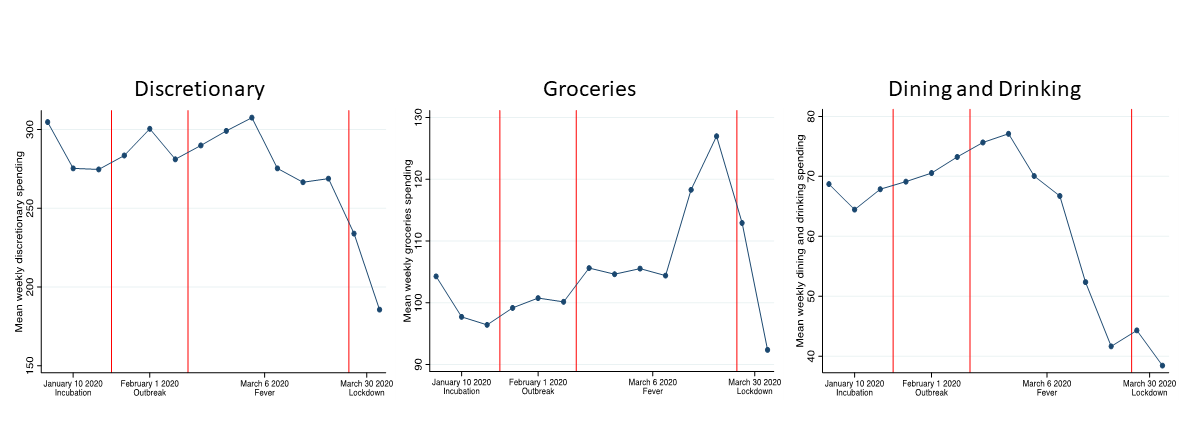Since the first UK cases were reported in the city of York in January 2020, the COVID-19 virus has spread rapidly and the UK has become one of the worst affected countries in the world.1 As the virus spread, the UK government and devolved administrations introduced successive public health measures, culminating in late March 2020 with: enforced closures of non-essential businesses; prohibitions on large gatherings; cancellations of sporting events; extensive restrictions on freedom of movement; social distancing; and isolation of vulnerable individuals. Government and other estimates suggest that the spread of COVID-19 and resultant public policy interventions are having significant (albeit uneven) impact on UK household incomes and expenditures (Crawford et al. 2020, Lenoël and Young 2020, UK Office for National Statistics 2020a,b, Overman 2020).
Investigating the impact of COVID-19 and public policy interventions on consumer spending (or any other economic or social outcome) is challenging, given that official statistics are often produced with a significant time delay. Fortunately, recent advances in information technology have enabled the real-time collection of transaction-level data and allowed researchers to analyse consumer spending patterns as they occur (Aladangady et al. 2019).
Three notable studies for Denmark, Spain, and the US present evidence on the effect of COVID-19 on consumer spending. Andersen et al. (2020) use transaction-level bank account data from a large Danish bank to find a decline in spending – following the COVID-19 outbreak – which varies across expenditure categories and correlates with government restrictions. Carvalho et al. (2020a,b) utilise a large high-frequency point-of-sale transaction dataset from a major Spanish commercial bank to find large overall spending declines across various product categories, following a government lockdown. Baker et al. (2020) use transaction-level household financial data from a personal-finance website to observe a substantial increase in consumer spending as COVID-19 cases increase, followed by a significant decline in general spending. The authors also observe heterogeneity in spending responses across states (depending on the severity of the virus outbreak).
In a recent analysis (Chronopoulos et al. 2020), we examine consumer-spending responses to the onset and spread of COVID-19 and the subsequent government-imposed lockdown in Great Britain. We utilise data from a personal finance app produced by the UK-based FinTech company Money Dashboard, which aggregates all transactions from linked bank accounts and credit or debit cards for app users. Our sample contains approximately 20 million anonymised transactions carried out by 100,000 individuals over the period 1 January 2020 to 7 April 2020.2
We partition our sample period into four phases, called incubation, outbreak, fever, and lockdown:3
- Incubation: 1 to 17 January
- Outbreak: 18 January to 21 February
- Fever: 22 February to 22 March
- Lockdown: From 23 March, when Prime Minister Johnson declared that every individual (barring non-essential workers) should stay at home unless taking necessary exercise or purchasing essential food and medical items, and that non-compliance would be subject to police intervention and enforcement.
Real-time consumer spending responses
We examine total discretionary spending (defined as the sum of spending in categories such as groceries, dining and drinking, alcohol, gambling, games and gaming, and other related items, which individuals can influence directly) and specific spending categories such as groceries and expenditures in going out (dining and drinking).
Figure 1 shows the weekly average discretionary spending (£) per individual, as well as spending on groceries and on dining and drinking. The period of analysis is partitioned into incubation, outbreak, fever and lockdown phases.
Figure 1 Weekly average spending per individual in Great Britain (for discretionary spending, groceries, dining and drinking)
Discretionary spending is largely flat throughout the first three (incubation, outbreak, fever) phases of the pandemic, before declining around week nine of the sample period. The largest decline occurs during the first two weeks of the lockdown phase, where average discretionary spending is at an all-year low.
Except for seasonal spending in the first week of January, spending on groceries remains relatively flat throughout the incubation phase and continues in this manner until the last week of the outbreak period. This is followed by elevated spending in the first part of the fever phase. There is a strong increase in groceries spending for the two weeks following the WHO designation on 11 March 2020 of COVID-19 as a pandemic. This is consistent with so-called consumer stockpiling behaviour, which was widely reported by UK news media. 4 Groceries spending declines considerably as the UK enters the lockdown phase.
Similar to overall discretionary and groceries spending, there is a steady increase in spending on dining and drinking in the first eight weeks of the crisis. We observe an increase of more than 11% in spending between the first week of the year until two weeks into the fever phase. However, shortly after week 13, spending on these items declines by 47.1% within four weeks. Contrary to government advice to refrain from going out for non-essential activities, it appears that individuals spent slightly more around the time of the lockdown announcement than they did in the days leading up to it.
The demographic information in the dataset allows us to examine consumer spending across gender, age, and income. Figure 2 summarises the trends of overall discretionary spending by demographic group. We find that male, older, and higher-income individuals spend significantly more in all spending categories compared to female, younger, and lower-income counterparts. The week-to-week changes in behaviour are similar across most demographic characteristics and spending categories.
Figure 2 Overall discretionary spending in the UK (by gender, age, and income)
Two patterns emerge. First, the spending gaps observed between gender, age, and income groups diminish over time and begin to converge during the lockdown phase.
Second, as Figure 3 illustrates, there are noteworthy differences in dining and drinking spending across younger and older individuals. Specifically, younger individuals reduce their spending in this category almost three weeks earlier than older counterparts. This suggests that official warnings regarding the severity of COVID-19 and advice to avoid non-essential activities were heeded more readily by younger individuals.
Figure 3 Dining and drinking expenditures by age group
Conclusions
The findings suggest that the COVID-19 virus and public health interventions instituted by the UK government are having significant effects on the level and composition of consumer spending across Great Britain. However, these effects are not uniform: there are differences across gender, age, and income level.
Our results provide a starting point for policymakers in understanding the real-time and varied impact of COVID-19 and associated public policy interventions on consumer spending across Great Britain. Our results also provide a basis for further in-depth investigations of consumer-spending behaviour as the crisis and public policy responses evolve.
References
Aladangady, A, S Aron-Dine, W Dunn, L Feiveson, P Lengermann and C Sahm (2019), “From transactions data to economic statistics: Constructing real-time, high-frequency, geographic measures of consumer spending”, NBER Working Paper 26253.
Andersen, A, E T Hansen, N Johannesen and A Sheridan (2020), “Consumer responses to the COVID-19 crisis: Evidence from bank account transaction data”, CEBI Working Paper Series.
Baker, S R, R A Farrokhnia, S Meyer, M Pagel and C Yannelis (2020), “How does household spending respond to an epidemic? Consumption during the 2020 COVID-19 pandemic”, NBER Working Paper 26949.
Baldwin, R, and B Weder di Mauro (eds.) (2020a), Economics in the time of COVID-19, a VoxEU.org eBook, London: CEPR Press.
Baldwin, R, and B Weder di Mauro (eds.) (2020b), Mitigating the COVID economic crisis: Act fast and do whatever it takes, a VoxEU.org eBook, London: CEPR Press.
Carvalho, V M, J R Garcia, S Hansen, Á Ortiz, T Rodrigo, J V Rodríguez Mora and J Ruiz (2020a), “Tracking the COVID-19 crisis with high-resolution transaction data”, Cambridge-INET Working Paper 2009.
Carvalho, V M, J R Garcia, S Hansen, Á Ortiz, T Rodrigo, J V Rodríguez Mora and J Ruiz (2020b), “Tracking the COVID-19 crisis through the lens of 1.4 billion transactions”, VoxEU.org, 27 April.
Chronopoulos, D, M Lukas and J O S Wilson (2020), “Consumer spending responses to the COVID-19 pandemic: An assessment of Great Britain”, Centre for Responsible Banking and Finance Working Paper 20-12.
Crawford, R, A Davenport, R Joyce and P Levell (2020), “Household spending and coronavirus”, IFS Briefing Note BN279.
Lenoël, C, and G Young (2020), “Prospects for the UK economy”, National Institute Economic Review 252: F10-F43.
UK Office for National Statistics (2020a), “Coronavirus, the UK economy and society, faster indicators: 23 April”, London: Office for National Statistics.
UK Office for National Statistics (2020b), “Coronavirus and the social impacts on Great Britain: 23 April”, London: Office for National Statistics.
Overman, H (2020), “How the UK government should respond to the unequal local economic impacts of COVID-19”, VoxEU.org, 22 April.
Ramelli, S, and A F Wagner (2020), “What the stock market tells us about the consequences of COVID-19”, in R Baldwin and B Weder di Mauro (eds), Economics in the time of COVID-19, a VoxEU.org eBook, London: CEPR Press.
Endnotes
1 Baldwin and Weder di Mauro (2020a, b) provide an extensive edited collection of essays written by leading economists regarding the likely effects of COVID-19 on trade, finance, travel and monetary policy among others.
2 The results of our analysis – which also include comparisons in consumer-spending responses across the nations (England, Scotland, Wales) and regions (East Midlands, East of England, London, North East, North West, Scotland, South East, South West, Wales) – will be updated regularly and made available at the Centre for Responsible Banking and Finance.
3 Ramelli and Wagner (2020) partition their sample period in a similar fashion in order to assess stock-market reactions to COVID-19. They find that the overall stock-price reaction varies with extent of international trade exposure; firms with global value chains experience larger declines in value.
4 See for example “Coronavirus: Supermarkets ask shoppers to be 'considerate’ and stop stockpiling”, BBC News, 15 March 2020.







